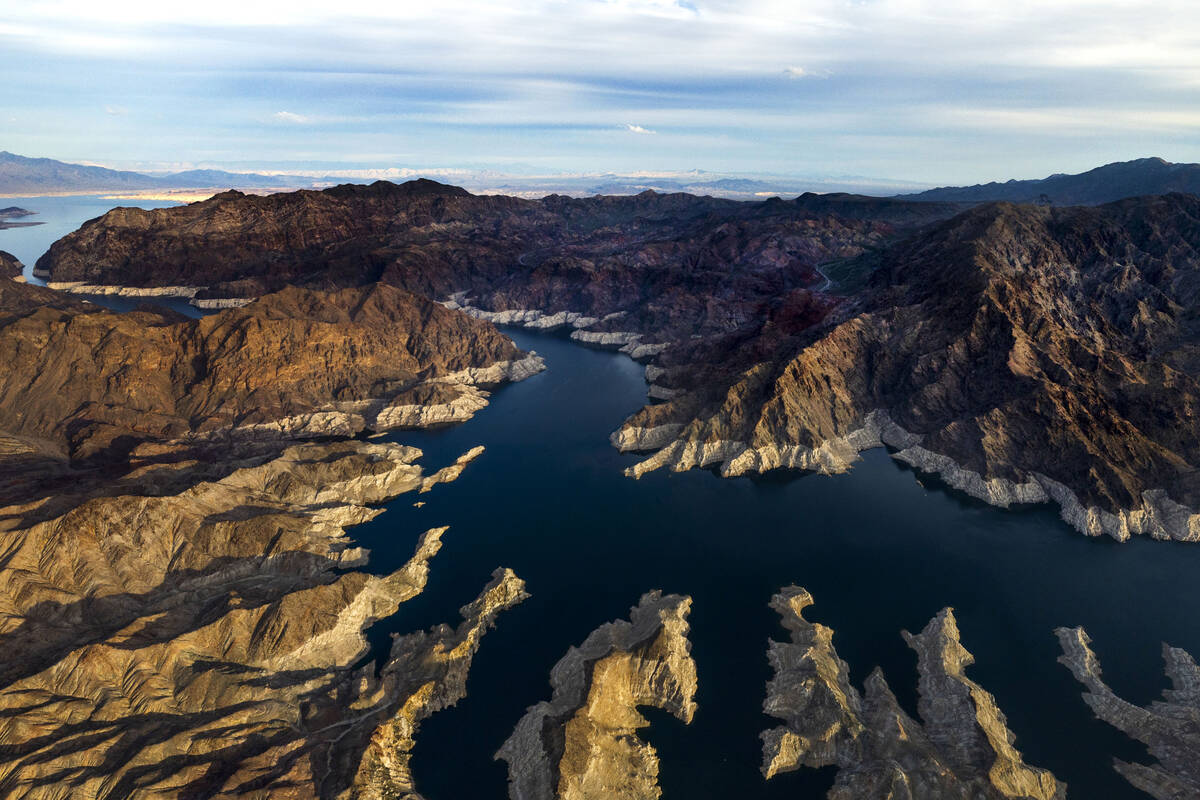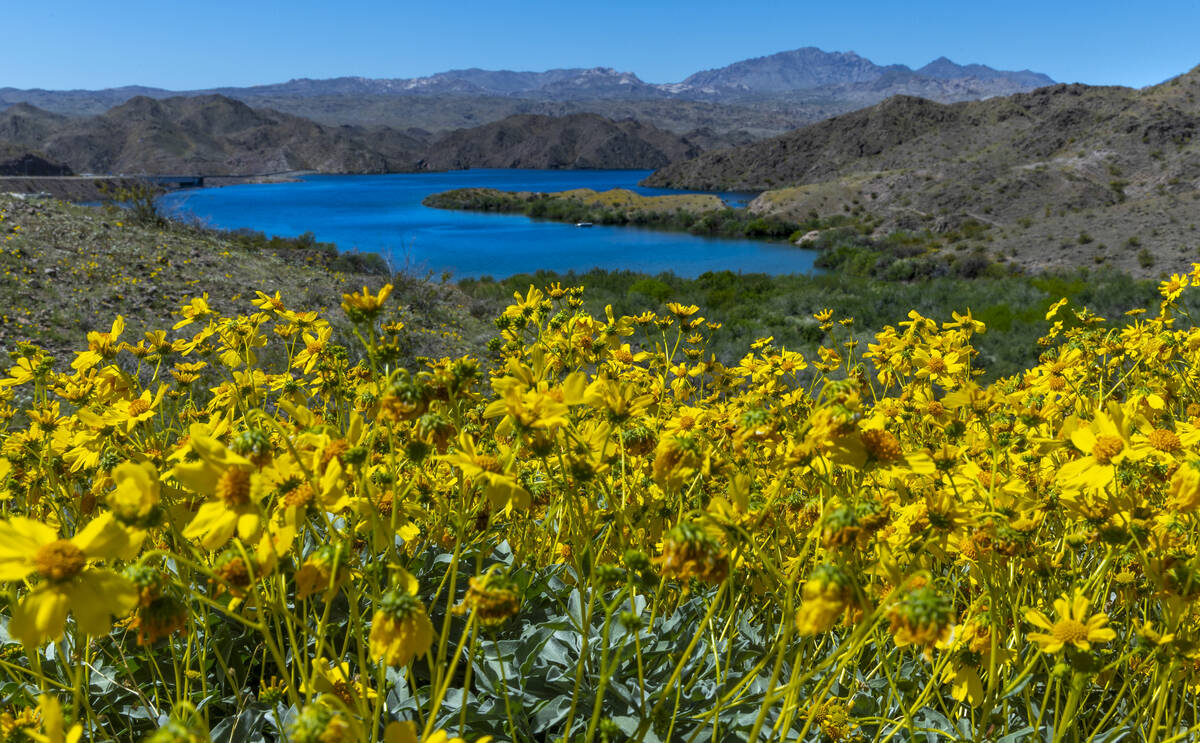What happens to Las Vegas’ water under feds’ Colorado River cuts?
The federal government this week laid out groundwork that sets the stage for substantial cuts to Nevada and other states that draw water from the Colorado River in the event that Lake Mead continues its two-decades-long fall.
The goal of the proposals, federal officials said in announcing the plans, is to protect the minimum “responsible” water levels needed to maintain hydropower generation at the dams at the river’s two major reservoirs.
Deputy Interior Secretary Tommy Beaudreau on Tuesday described the two proposals not as a choice between one or the other but rather bookends on either side of a spectrum to guide further discussions about how best to implement the reductions.
For Nevada, the cuts on either end of that spectrum would prove devastating should Lake Mead near 950 feet in elevation, the lowest point at which water can turn the power generating turbines at Hoover Dam. One proposal calls for Southern Nevada’s share of the Colorado River to be cut by slightly less than half (146,000 acre-feet) at that point, while the other would shave the state’s allocation by slightly more than half (160,000 acre-feet).
The two proposals show that “the tools available to the federal government are very blunt,” said Southern Nevada Water Authority General Manager John Entsminger — tools that the the lower basin states can use to come up with a more palatable alternative between now and the end of May.
“There’s not a lot of nuance between these alternatives. And if we want anything with any more sophistication, any more calibration by state, by sector, that’s up to the states and the water users to produce that,” Entsminger said.
Both proposed alternatives from the federal government call for the same volume of cuts for the next three years: up to 1 million acre-feet in new cuts next year and up to 3 million in new reductions in 2025 and 2026. Those reductions would be on top of cuts under two other current agreements: the 2007 interim guidelines for the river and the 2019 Drought Contingency Plan.
One alternative would follow a strict priority system, which largely protects the oldest and most senior water rights to the river in California’s farming sector while imposing hefty cuts to major cities like Las Vegas, Phoenix and Los Angeles. The other alternative would share those reductions more proportionally across Nevada, Arizona and California.
A question of equity
The two federal alternatives are similar in many ways to a pair of proposals put on the table by the seven Colorado River states in January. The plans put forward by California hewed closely to the strict priority standard, while a joint proposal from the other six states sought to spread the cuts more equally.
Entsminger said the inclusion of a proposal that analyzes proportional cuts is a positive step in acknowledging the need for a different path for how the river should be governed in the future.
But equity, he said, is inherently a subjective term.
“For a region like Southern Nevada that’s already reduced our water use by 31 percent to be told to reduce by the exact same proportion as some folks who haven’t cut at all doesn’t fit in my definition of equity,” Entsminger said.
A key difference between the federal government’s plans and those put forward by the states is when those cuts would be made. Both federal alternatives propose smaller volumes of cuts next year as compared with the two state proposals, which called for bigger cuts at higher elevations at Lake Mead.
“What’s puzzling about the federal proposal is that it does not take advantage of the opportunity by agreement by all seven states that deep cuts are needed at higher elevations,” said John Fleck, a water researcher at the Utton Center at University of New Mexico School of Law.
The snowpack in the Upper Colorado River Basin has been far better than anticipated, and now ranks as the second highest since 1979.
Fleck said the federal alternatives taking the modest route for the coming snow year “seems like a real missed opportunity.”
Most water users in the lower basin, especially those in California, have shown no urgency in voluntarily conserving Colorado River waters. California is forecasted to use almost its entire 4.4 million acre-foot allotment from the river this year, according to the most recent weekly forecast published by the Bureau of Reclamation.
Southern Nevada stands out as an exception, Fleck said, as the region is on pace to once again use far less than what it is legally allowed to pull from the river.
Related: Saving for a non-rainy day: How much water has Southern Nevada stashed away?
The federal government’s more modest approach to cuts in 2024, Fleck added, has a very practical effect of slowing the recovery of the Colorado River system and could keep Lake Mead as much as 10 feet lower when compared with the proposals that were submitted by the states.
“Our problem all along has been our unwillingness to cut deeply enough to slow the drop of the reservoirs. And more importantly, our problem is when we get good water years is to just use it,” Fleck said. “But this is an opportunity for the states, and other interested parties, to say no, we need to do more.”
Threat of litigation
Doing more is something the basin states, and especially Arizona, Nevada and California, will focus on over the next 45 days as the government accepts public input on its draft proposals.
The threat of litigation is something that looms large over those discussions as water users seek to hold on as tightly as possible to their legal water rights.
But that is an outcome that states say needs to be avoided at all costs.
Tom Buschatzke, director of the Arizona Department of Water Resources, said Tuesday that the federal government’s alternatives each have “dire consequences,” which could include lawsuits.
“Our task is to avoid that litigation outcome,” Buschatzke said. “Once litigation occurs, if it does, it’s going to be very difficult to negotiate something forward.”
J.B. Hamby, chairman of the Colorado River Board of California, agreed with those sentiments.
Projections from the Bureau of Reclamation show that Lake Mead, which currently sits at barely one-quarter full, could reach “dead pool” in just a few years, meaning water would no longer be able to flow through Hoover Dam downstream to Arizona and California.
“We can see from the bathtub rings, we don’t have a lot more flexibility left in the system,” Hamby said. “So litigation is not a good outcome if we want to have water in canals and in taps.”
Federal cuts, local restrictions
While the three lower basin states work to hash out a more palatable alternative to those put forward by the federal government, water managers in Southern Nevada are also preparing for a future where drastic cuts could be imposed.
That potential laid out this week underscores the water authority’s recent push at the state Legislature, where lawmakers are mulling over a bill that would give the agency the power to limit residential water use under federally declared shortages on the Colorado River, which provides roughly 90 percent of Southern Nevada’s water.
Assembly Bill 220, if approved, would be the first of its kind in the nation to give a water agency the power to restrict water use on individual homes.
“These are obviously steps that we never want to ask the community to take. But under a scenario where the federal government tries to impose something like this as early as August for the start of the water year, our Legislature wouldn’t be scheduled to come back into session for 18, 20 months,” Entsminger said. “We need at the local elected official level to be able to respond in real time to these evolving circumstances.”
The bill cleared its first hurdle Monday after the Assembly Committee on Natural Resources voted to send the bill to the full Assembly for a floor vote.
Contact Colton Lochhead at clochhead@reviewjournal.com. Follow @ColtonLochhead on Twitter.



















